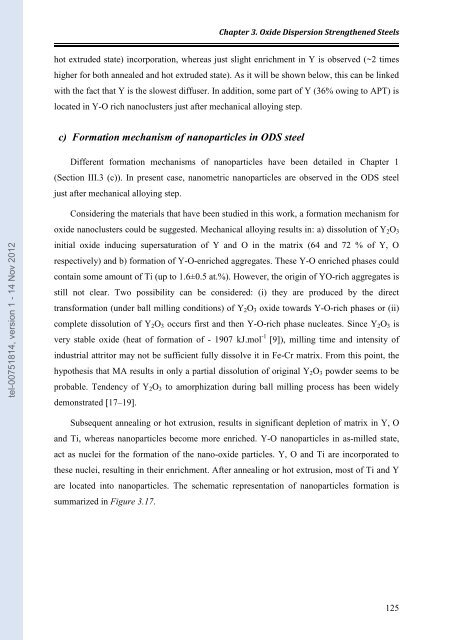Etude par Sonde Atomique Tomographique de la formation de nano ...
Etude par Sonde Atomique Tomographique de la formation de nano ...
Etude par Sonde Atomique Tomographique de la formation de nano ...
Create successful ePaper yourself
Turn your PDF publications into a flip-book with our unique Google optimized e-Paper software.
tel-00751814, version 1 - 14 Nov 2012<br />
Chapter 3. Oxi<strong>de</strong> Dispersion Strengthened Steels<br />
hot extru<strong>de</strong>d state) incorporation, whereas just slight enrichment in Y is observed (~2 times<br />
higher for both annealed and hot extru<strong>de</strong>d state). As it will be shown below, this can be linked<br />
with the fact that Y is the slowest diffuser. In addition, some <strong>par</strong>t of Y (36% owing to APT) is<br />
located in Y-O rich <strong>nano</strong>clusters just after mechanical alloying step.<br />
c) Formation mechanism of <strong>nano</strong><strong>par</strong>ticles in ODS steel<br />
Different <strong>formation</strong> mechanisms of <strong>nano</strong><strong>par</strong>ticles have been <strong>de</strong>tailed in Chapter 1<br />
(Section ΙΙΙ.3 (c)). In present case, <strong>nano</strong>metric <strong>nano</strong><strong>par</strong>ticles are observed in the ODS steel<br />
just after mechanical alloying step.<br />
Consi<strong>de</strong>ring the materials that have been studied in this work, a <strong>formation</strong> mechanism for<br />
oxi<strong>de</strong> <strong>nano</strong>clusters could be suggested. Mechanical alloying results in: a) dissolution of Y2O3<br />
initial oxi<strong>de</strong> inducing supersaturation of Y and O in the matrix (64 and 72 % of Y, O<br />
respectively) and b) <strong>formation</strong> of Y-O-enriched aggregates. These Y-O enriched phases could<br />
contain some amount of Ti (up to 1.6±0.5 at.%). However, the origin of YO-rich aggregates is<br />
still not clear. Two possibility can be consi<strong>de</strong>red: (i) they are produced by the direct<br />
trans<strong>formation</strong> (un<strong>de</strong>r ball milling conditions) of Y2O3 oxi<strong>de</strong> towards Y-O-rich phases or (ii)<br />
complete dissolution of Y2O3 occurs first and then Y-O-rich phase nucleates. Since Y2O3 is<br />
very stable oxi<strong>de</strong> (heat of <strong>formation</strong> of - 1907 kJ.mol -1 [9]), milling time and intensity of<br />
industrial attritor may not be sufficient fully dissolve it in Fe-Cr matrix. From this point, the<br />
hypothesis that MA results in only a <strong>par</strong>tial dissolution of original Y2O3 pow<strong>de</strong>r seems to be<br />
probable. Ten<strong>de</strong>ncy of Y2O3 to amorphization during ball milling process has been wi<strong>de</strong>ly<br />
<strong>de</strong>monstrated [17–19].<br />
Subsequent annealing or hot extrusion, results in significant <strong>de</strong>pletion of matrix in Y, O<br />
and Ti, whereas <strong>nano</strong><strong>par</strong>ticles become more enriched. Y-O <strong>nano</strong><strong>par</strong>ticles in as-milled state,<br />
act as nuclei for the <strong>formation</strong> of the <strong>nano</strong>-oxi<strong>de</strong> <strong>par</strong>ticles. Y, O and Ti are incorporated to<br />
these nuclei, resulting in their enrichment. After annealing or hot extrusion, most of Ti and Y<br />
are located into <strong>nano</strong><strong>par</strong>ticles. The schematic representation of <strong>nano</strong><strong>par</strong>ticles <strong>formation</strong> is<br />
summarized in Figure 3.17.<br />
125

















